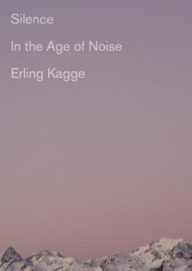 Erling Kagge
Erling Kagge
Translated by Becky L. Crook
Pantheon ($20)
by Adrian Glass-Moore
Many of us live under constant attack by noise, a most insidious enemy since it passes itself off as a friend. We are likely to say "it's too quiet" whenever silence wins a brief (and it is always brief) victory over noise. Erling Kagge, a Norwegian adventurer, achieved extreme silence when, in 1993, he walked alone for fifty days in Antarctica to the South Pole. He purposefully discarded the batteries to his radio at the trip's outset, leaving him confidently devoid of any human contact for the duration.
"I was never bored or interrupted," Kagge writes of the experience in Silence: In the Age of Noise. "I was alone with my own thoughts and ideas. The future was no longer relevant. I paid no attention to the past. I was present in my own life." The book could just as aptly be titled Presence, which writer Fran Lebowitz argues persuasively is increasingly rare. If you are in the street and looking down at your phone, then you aren't in the street, she says—you're on your phone. It follows that had Kagge traversed Antarctica while tuned in to the radio, he would have been tuned in to the radio, not in Antarctica.
Thus, we can say that not only did Kagge travel to extreme places, he was there when he did so. This puts Kagge in a unique position to dispense information he gathered which we are unlikely to obtain on our own, since we are neither likely to visit such extreme places nor forego distractions while we are there. Whatever knowledge Kagge possesses he transfers largely by osmosis. He doesn't spell it out for us, opting instead to spread his ideas over thirty-two wide-ranging micro-essays, each no more than a few pages.
Silence is not only found in silence. Kagge found it on top of the Williamsburg Bridge, spanning the East River between Manhattan and Brooklyn, which he climbed with a fellow "urban explorer" in 2010. "I heard nothing," Kagge writes. "Below me, the traffic thundered past in four lanes, while the subway pounded rhythmically on its way in and out of the city centre. I was consumed by all that I saw and I shut out all the noise. You cannot wait for it to get quiet." Kagge also found silence, or presence, or beauty—whatever you want to call it—during a trudge through New York City's sewer system. Despite the "ceaseless noise," he writes, there was a "negative beauty—by virtue of all that is not present."
Kagge defines silence broadly as a state of mind, one that can be achieved without moving to Antarctica. But the fact is he did go to Antarctica. There is an urge within many of us to escape the physical din, not simply to tune it out. "It is not enough to withdraw from the mob, not enough to go to another place," wrote Michel de Montaigne. "It is our own self we have to isolate and take back into possession." Yet more than 400 years after Montaigne wrote that, physical displacement retains its allure, including for Kagge, who writes that he once "flew eighteen hours from Oslo to Sri Lanka in order to relax." Aware of the irony, Kagge can't help but report, "It was fabulous."
